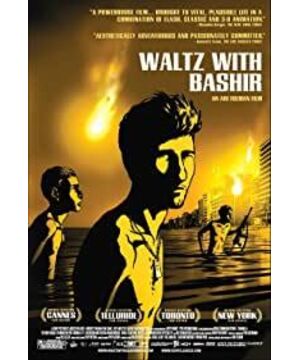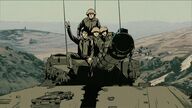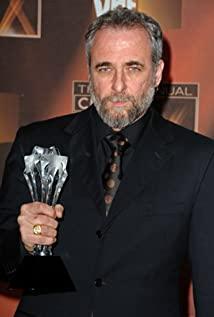This isn't the first time someone has tried to combine animation and documentary formats, or even the first time such films have won international awards. There was a short film that justly claimed to be an animated documentary, Ryan (2004) by Canadian animator Chris Landreth, which won the 2005 Academy Award for Best Animated Short Film. Before that, it has won at least three other film festival awards for best animation, best short film and so on. However, despite its reputation, people still discuss its gorgeous CG effects, animation technology, topicality of the subject itself and surreal image design, silently ignoring the label it puts on itself: documentary. It silently said that I am an animated documentary, not a pure animation. However, it seems that even the creators themselves are a little guilty, and they want to bundle a documentary filmed by traditional methods, "About Ryan (Alter Egos)" when the DVD is released, and let Chris and Ryan sit on the camera separately. Before, talk about their own life, talk about their own thoughts, as if the two of them couldn't talk enough in that fourteen-minute clip. Despite the superior quality of the film itself, Ryan's positioning of itself didn't raise enough conversations. Until 2008, Israeli director Ari Folman brought his Waltz with Bashir. Bashir)", not only swept 43 awards, 57 nominations, more surprisingly, the pile of nominations and won awards not only include "Best Animated Feature", but also "Best Picture" ", "Best Foreign Language Film" (such as an Oscar nomination). I don't know how many animation directors have ever, at least for a moment, had the dream of beating live-action movies, although most people know that animation and live-action movies are different art forms, and there is absolutely no need to compare them. And Folman, a director who was born in film and TV documentary, with a heavy blow, deeply shook the "animation" that was born to coexist with "fiction" and the "documentary" that has always been regarded as the strongest position of "real" "barriers between. "Why would you make a documentary in animation?" In hundreds of interviews, hundreds of reporters, repeated this question to Folman hundreds of times, even if they had already gotten the answer from other press releases. They just want to hear him say: "Because I can't tell this story any other way. It's the only way." The nightmare of the dog chase. He claimed it had something to do with their experience in the Lebanon war (the fifth Middle East war) 20 years ago. Folman, however, found his memory of the war largely absent. In order to reconstruct his own experience and restore part of the truth about the massacre in the Palestinian refugee camps in Sabara and Shatila, Folman interviewed his comrades, several soldiers, psychological counselors, and the first war reporter who entered the scene after the massacre. This film was made by reproducing his own experiences of seeking visits, what the interviewers told, as well as the hallucinations and nightmares he encountered when he regained his memory. So this is first and foremost a deeply personal documentary about Folman himself going through PSTD (Post Traumatic Stress Syndrome) and rebuilding his memories. He also emphasized on various occasions that "this is not a political movie". ——However, since the film has been released and has caused repercussions, this is not something he can say for a long time. Israel promotes this film in the name of the country and sends it to exhibitions everywhere, dare to say that it is not showing its cultural tolerance in a big gesture? Criticisms outside of honor also point to the film's lack of self-reflection on Israel's war behavior, and even the suspicion of glorifying the Israeli army. The Lebanese classmate in my class, as a national of the invaded country (this classmate lived in Beirut, which was bombed that year, and was attacked again in 2006), bluntly said that this film is very problematic in terms of position (very problematic). The issue of position, however, is by no means unique to the film. There is no work without a stand in the world, let alone involving such a sensitive subject, controversy is inevitable. "Authenticity" is the most controversial quality of documentaries. Here, it is impossible to make an absolutely politically correct discussion and comment on it. It can only be said that the most unexpected part of this film is the "reality" constructed under its worldview. As something completely created by the author out of thin air, the most fundamental difference between painting and photos/videos is that there is no direct indexicality to reality. The so-called "indicative", at the beginning of photography technology, specifically refers to the image of the real object on the light-sensitive negative film, which is formed by chemical burning on the negative film, which is pure material; Autocomplete is regarded by Bazin and other scholars of photographic ontology as the most objective reproduction of reality, and it plays an important temporal role in reappearing the past that has disappeared. While framing and editing can also guide/mislead the viewer, indicative has always been the most important feature of the image recording. However, this "indicative" has long been challenged or even disappeared after the development of digital technology. All images, all shapes and colors, have been converted into timeless binary information, which can be easily transferred and changed at any time. If you don't speak human words, this has made a theoretical foreshadowing for the academic circles and a psychological foreshadowing for the audience for the emergence of the mixed genre of animated documentary. Speaking in human words, as Folman said in an interview: "How do you tell me which is more real? My animated image, or any camera or TV screen of me made up of pixels?" This question Currently unsolved. Because there is no solution, it is difficult for anyone to hit a straight ball to object to the authenticity of the documentary. The only full paper makes the argument that the film uses a lot of fictional techniques in the reenactment of the scene, such as reverse shots, subjective shots, and of course those deliberately satirical soundtracks… … This is not the only thing that made traditional documentarians frown during the making of the film. Don't talk about the stuntman issue. In order to protect the privacy of the subject, this situation is allowed. The film features two interviewees, Boaz and Carmi, who use the voices and images of other actors in their place. Although the characters in "Ryan" have been completely artistically processed, the recordings are at least live recordings, and a sharp ear can tell the source Unclean background noise. However, all of Bashir's interviews are done in dedicated recording studios - although the interview locations depicted in the film vary. When Folman was invited to a seminar at the University of Chicago, he explained this: When watching animation, the human ear is very sensitive to background noise, so it must be avoided. Moreover, when filming a documentary normally, the director and the subject have a special sense of intimacy and presence. For example, you follow a person to meet his girlfriend ten years ago, and witness this moment with him. There is an emotion in this shot. But doing animation is different. You say a word, the animator will do it for a month. The sense of presence is long gone, so why pretend? The controversy brought about by this embarrassing positioning issue is also a major reason why the film has gained public attention. However, in the field of artistic creation, practice always takes precedence over theory. Arguing is normal, and even a value in itself. Back to the form of animation. Compared with live-action shooting, the biggest feature of animation is that the creator has absolute control over the picture. Everything that appears in the foreground and background, the lighting and color matching of each frame, is not unintentional. Therefore, as a documentary that records "personal experiences" as claimed by the director himself, animation has a natural advantage in expressing the director's subjective feelings. It can be said that it shoots what exists in the mind of the subject/director. For a film that mainly shows the psychological state of the subject and reflects the process of acquiring knowledge, the importance of subjective truth is obviously greater than that of objective truth. In terms of painting style, the film takes the line of realistic imagery and surreal colors: unadorned thick lines, thick black shadows, high contrast, and unpleasant complementary colors everywhere. These two pictures are from Boaz's dream and Folman's dream. Color is crucial. This iconic yellow color appears in almost all killing-related scenes, more often than the traditional blood, as if the sun shone on the earth in place of death. This can't be more clearly reflected in the signal flare scene at the end. It was also at that moment that the audience understood why this color was chosen as the tone of the entire film. It was perhaps the brightest color on the battlefield in Folman's own memory. Supplemented by the gloomy violin soundtrack, his nightmares appeared several times throughout the film, causing great spiritual pollution to the audience.
View more about Waltz with Bashir reviews








